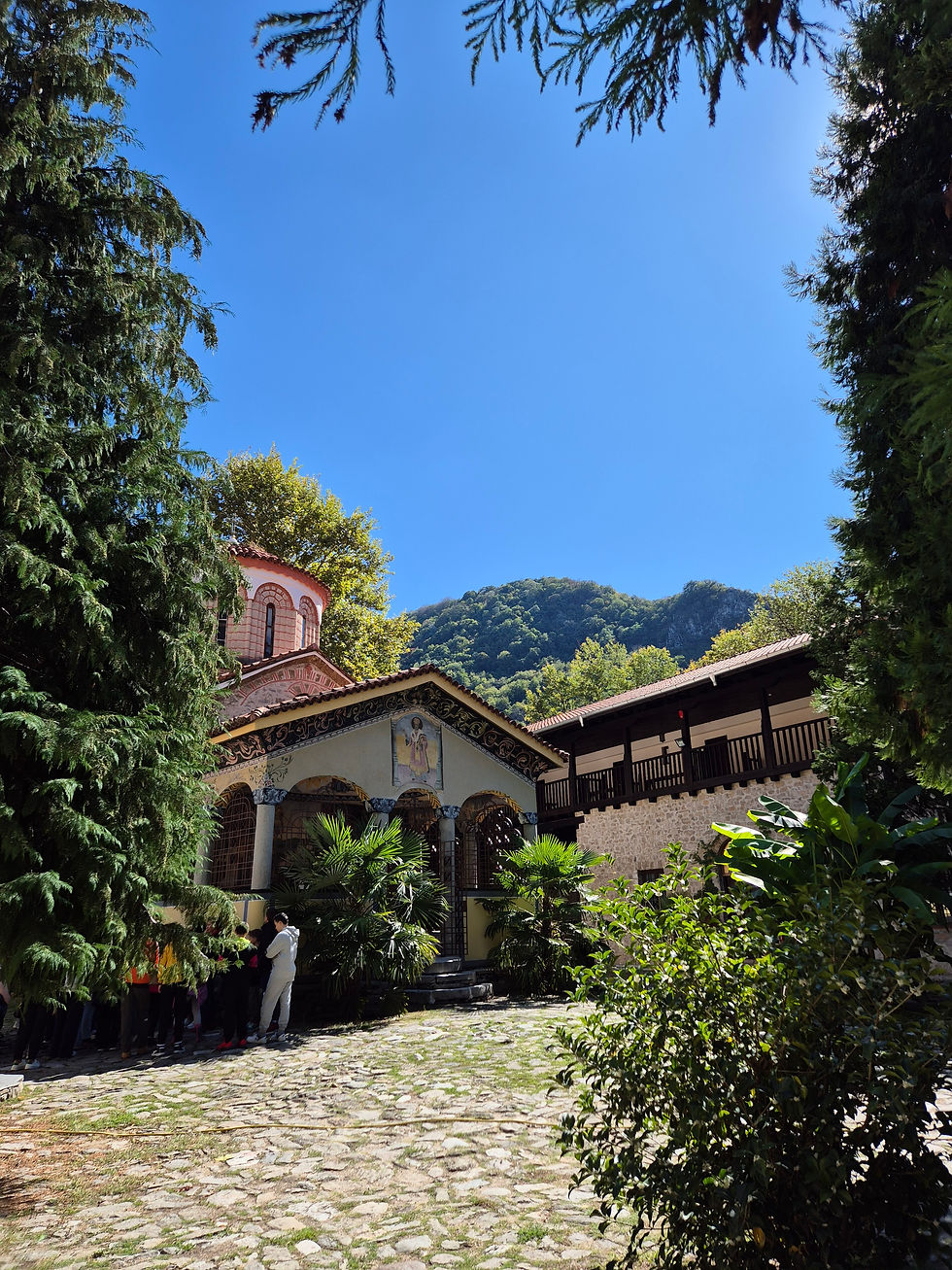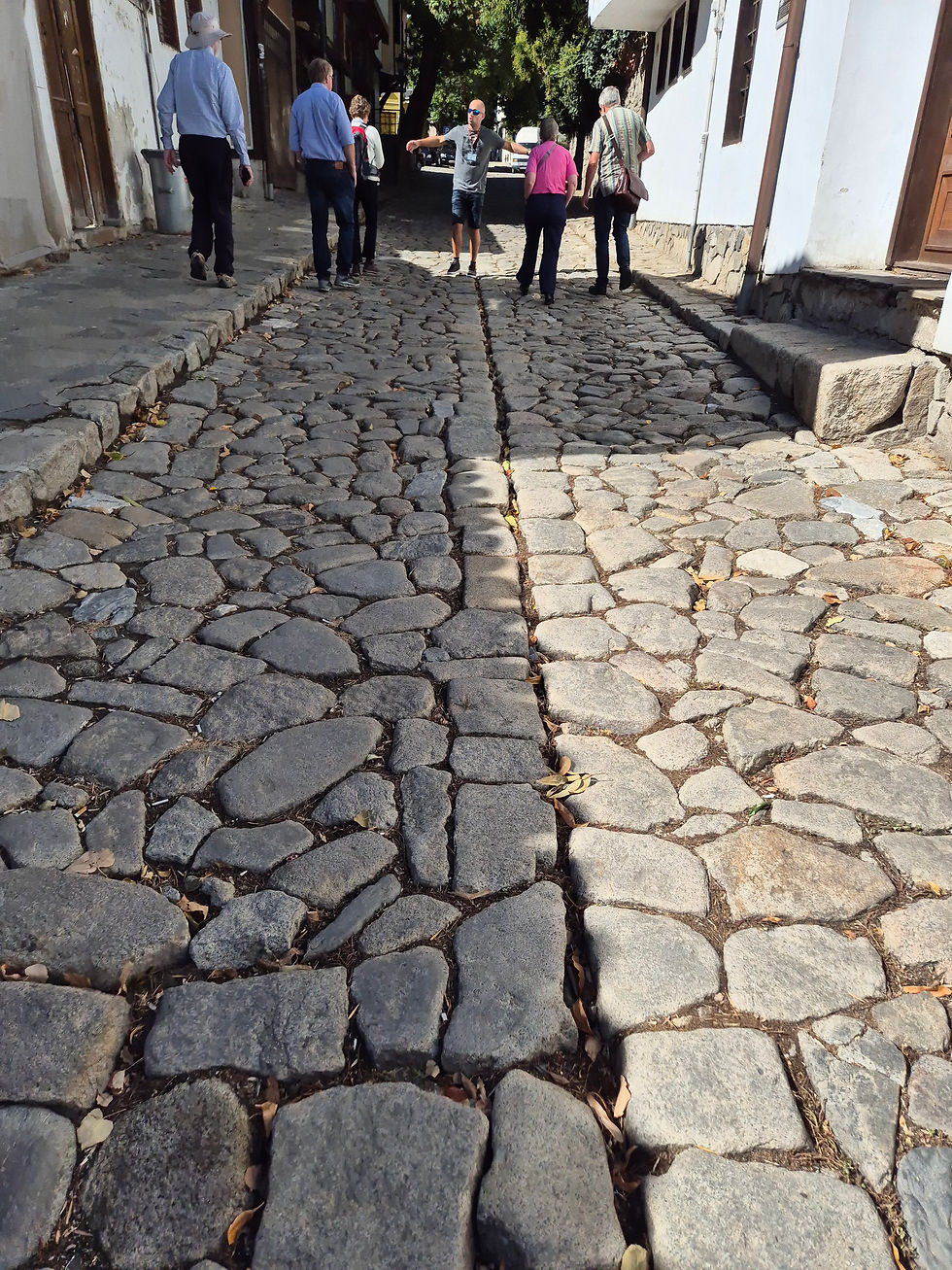Mystery tour Autumn 2024 - Post 5 Overland to Bulgaria
- Anne B 10milesfrom

- Oct 2, 2024
- 7 min read
Updated: Oct 6, 2024

Today was different. For the first time on our trip it was supposed to rain, the temperature had dropped by about 10°C, and we were spending a whole day travelling! A good way to use a rain day! A very early start saw us at Brasov station at 06.30 ready for our train to Bucharest, which, in complete contrast with our train to get here, was empty, fast and on time! Which was lucky because we needed to connect with the one train per day that goes to Sofia in Bulgaria. Here is Chris looking super excited about the upcoming 12.5 hours of train travel!

The shopping bag contains our provisions. They were needed because our 10 hour train to Sofia is just 2 old carriages with no food or drink available.
Our 2nd train arrived, and it had 3 carriages. One Turkish, one Bulgarian and ours, which was Romanian, and a compartment corridoor train. The old seats had gone a bit soft... and were incredibly comfy as a result! My big concern were toilet facilities, as 10 hours was too long for leg crossing! The loo was a very old metal loo that was quite rusty and a bit smelly but clean. The best bit was the sink. A brand new bar of pink soap but no water! It could have been worse!
Travelling wise, we were so lucky. We shared the compartment with a charming, well travelled and entertaining Canadian couple, originally from St Lucia, so between us we had many stories to share and tips to exchange which made the journey pass more quickly than it might have done. The border between Romania and Bulgaria is the middle of the Danube River! So you stop at the station before it for about 20 minutes. Both countries are in the EU, but not the Schengen trading zone, so passport formalities are required. A smart Romanian Passport officer came, collected all our passports and disappeared for 10 minutes. Then he returned and redistributed them in a formal but polite manner. 5 minutes later we moved off and then crossed the Danube on a rainy day, over the longest steel bridge in Europe, that made it impossible to photograph!

We then stopped at Ruse, the first station in Bulgaria. We were here even longer. The whole train crew changed so tickets were reinspected by a lady who must have got out of the wrong side of the bed that morning! Next a Bulgarian passport officer took all our passports and disappeared. He too returned eventually, and we were on our way. Although, disappointingly with no new passport stamps.
Formalities over we brought out our lunch time feast!

The Bulgarian section moved faster but stopped a lot. At one station, the Turkish carriage was removed to continue its journey south with a different engine, and we gained other carriages and a new guard for our continuation southwest towards Sofia. We were running about an hour late by now. Night fell, and at 21.20, a guard opened the compartment door and yelled an indecipherable instruction in Bulgarian. At that point, a young student who had got on a few stations previously, became our guardian angel. He spoke English and explained we had to change trains on the outskirts of Sofia because the track is being repaired! That was a performance as the train was not at a platform so we had to get down the steps, with luggage and jump the last bit! Then, across the tracks and onto a crowded local train. Then our angel heard us talking about taxis and said you must not get a taxi from the station at this time of night. He looked at where we were staying, and then where the other couple were staying and then took us to the metro and them to their bus stop after our farewells!

We were so grateful. The station was a scary place at that time of night. There was a group of young men, some with logos on their shirts that you could be arrested for in the UK, our angel pointed out drug dealers, and we were told it is a game for some people in that area to scam or scare some tourists! Eek! However, the metro was another world. It was very clean and felt safe, and our destination in the pedestrianised old town felt much safer too. Just a 5 minute walk to our air bnb, via a small shop for water and milk. No cereal so the breakfast bars I have been carrying from home for just this eventuality will be useful. We were so glad to get indoors into our charming studio apartment! Chris didnt waste any time putting the kettle on!

Next morning, everything felt better! There are many cities in the world where arriving late at night to their inner city railway station would not be pleasant! We had left the rain behind in Romania, and were picked up at 8.30 for a trip to the southeast of Bulgaria, a very important area historically.
The journey took us down the Maritsa river valley, bordered all the way by the Balkan Mountains to the north and the Rila and Rhodope range to the south. We saw the first snow of winter on the peaks. Bulgaria has several ski resorts, but like everywhere has been affected by climate change. We turned up into the mountains near Plovdiv and followed the pass into the mountains. This was Via Diagonalis or Militaris, the incredible Roman road connecting Constantinople, Plovdiv, Sofia and Belgrade. Our first stop was impressively perched Asen fortress, in a site first used in the 5th century BC to guard the pass. Spot the fortress!

The fortress was first built in the 9th century, and altered several times. Today it contains 2 chapels dating back to the 12th century.
We continued further up the valley to Bachkovo monastery, built in the 12th century.

It is a series of several small chapels surrounding the main monastery church, which once held over 200 monks. Today just a few remain.
The frescoes are once again stunning, and some are 400 years old. (Sorry there are so many posts like this, but they do take your breath away!)

This icon was hidden from the Ottomans, and rediscovered in 3 centuries later in a house in the village. We discovered that the icons were covered in silver because of the tradition of kissing the image, which destroyed the canvas or paper!

Finally we headed to Plovdiv, a remarkable city which is one of the oldest continually occupied cities in Europe. Much older than Rome, or Athens. The first settlers were here 8,000 years ago due to its favourable climate, sheltered by the mountains, fresh water and good agriculture. Once again it was invaded and conquered again and again, and each dynasty seemed to destroy or cover up much of what had gone before.
The Romans had a huge city here, possibly of a million people. They only discovered the wonderful theatre after a landslide in 1972,

and the huge arena is mainly under the shopping centre, but they have exposed one end.

This street is roman, with drainage down the middle.

Plovdiv has examples of 6th century byzantine walls and towers, and many houses built in the 1800s in a fairly unique style, as the Turkish rule was coming to an end.
The mosque, built in 1358, is still in use however.
We even got to sit up on the ladies balcony!

My favourite story is modern. A family built a beautiful house with a stunning view. They then paid a million euros for a plot of land behind it, hoping to build another house, but only got planning permission for 2 garages, so they are known as the million pound garages!
We had a super lunch at a little restaurant called Aylyakria.
Back to Sofia and out for an early evening walk. We try to stay in the heart of the city wherever we go so everything is walkable. Sofia centre is surprisingly beautiful, with lots of parks and gardens.
Our goal tonight is the huge Orthodox Cathedral, the Patriarch cathedral of Alexander Nevsky. It is a stunning building, and huge, holding 5000 people. Finished in 1912, it has a dramatic design and beautiful decoration.

We headed back via a supermarket and finally find some Granola for breakfast!
Next morning we set off early for a self guided walking explore of Sofia. We only have until 12.00! The first thing we saw was a lady painstakingly hoovering the pavement!

Our stops were as follows!
1. The Rotunda of St George.. built in the 4th century it was originally a roman baths but became a church. A very moving space to think people had worshipped here for 1500 years. Some of the frescoes date back to the 10th century.
2. The central mosque. It is still active, but closed this morning, the central market, built in 1879 but now adapted into a supermarket, and the Parliament.
3. The old ottoman thermal baths, built on the site of a hot spring, and now an excellent local history museum, containing finds from every period of Sofia's 10,000 year history.
This 24 carat gold bowl was incredible. Found in 1969, inside the 2 other bowls, it dates back to the iron age, about 850BC.

4. The actual hot spring, channelled into washing stations, or people collect the water and use it at home to soak hands or feet, or use on skin.
5. We also walked past so many beautiful buildings and lovely statues. There are excavation sites everywhere, most noticeably those uncovered at, and now surrounded by, Serdoca metro station. Sofia is really uncovering it's ancient past.
6. There are some great examples of striking street art!
We check out and have a speedy and excellent lunch at Mezza opposite the air bnb. A definite Turkish vibe and Chris had Efes beer which he loves!
Next, an experiment! We were being picked up by a service that is new to us. Daytrip.com provide a driver to take you between 2 places, with the option of sightseeing on the way. It is not cheap but very convenient, and worked well for our next trip as it enabled us to stop and see the famous Rila monastery, high in the mountains.The Daytrip experience was great. The driver was early, a very comfortable car, he spoke excellent English and was a good driver.
Rila monastery is definitely worth a visit.

The scenery was spectacular and the monastery is vast and beautiful.
Founded by a monk, the first church was built in 948 and the monastery was added to from this point. It once held 300 monks but today up to 60 stay here. 7 are permanent residents and caretakers.
The museum held some interesting pieces, including these 400 year old carved doors, and the amazing Rafail's cross, whittled by a monk in minute detail, and finished in 1802.


Due to its remote location Rila was left alone during the 500 years of Turkish rule, and some Ottoman leaders even issued edicts saying it must be allowed to continue unmolested!
Our drive continued to our next border where our driver also helped with passport control! But where next?!



















































































































































Comments